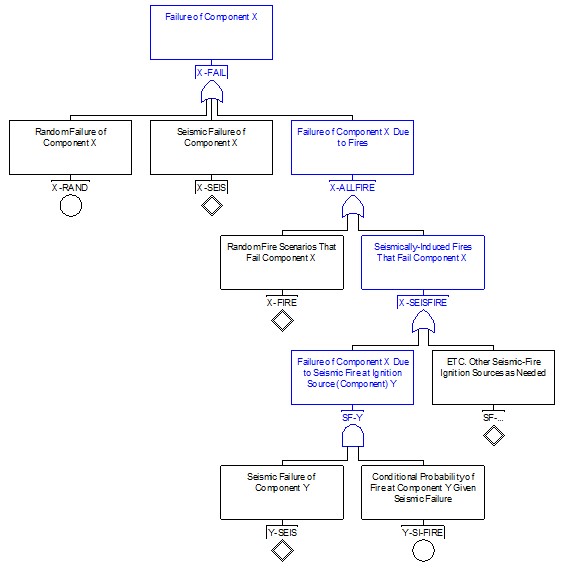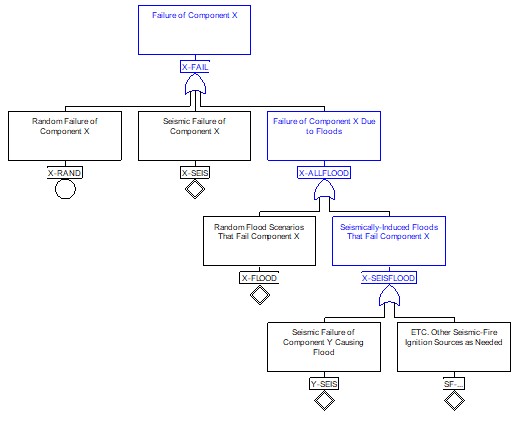Seismic Induced Fire and Flood (Task 3)
Task Overview
Objective
The objective is to assess postulated seismically induced internal fires and internal floods and screen out or explicitly include them into SPRA models.
Purpose
This section summarizes a process that can support risk-informed treatment of seismic-induced fires and floods including screening.
Guidance
An SPRA includes assessment (and modeling in some cases) of seismic-induced consequential hazards. A consequential hazard is one or more hazards that affect the plant as a result of the initial hazard. In the case of an SPRA, the seismic event is the initial hazard and seismic-induced internal flooding is an example of a consequential hazard. This task focuses on seismic-induced fires and floods.
Seismic-Induced Fire
Assessment of seismic-induced fires typically includes the following:
- Identification of potential seismic-induced fire sources
- Qualitative screening
- Quantitative screening
- Incorporation of unscreened seismic-induced fire scenarios into SPRA
Identification of Fire Sources
Fire sources (e.g., electrical equipment, flammable liquids) may be determined by plant walkdown or consulting an existing Fire PRA. Potential ignition sources are discussed in EPRI 3002000709 and 3002012980, with additional information provided in EPRI 1011989/NUREG/CR-6850 and EPRI 3002002936/NUREG-2169.
If there is an existing Fire PRA (FPRA), a list of specific possible sources for seismically induced fires may be derived from the FPRA. Without a Fire PRA, ignition sources may be initially identified by reviewing the SEL, plant information sources, and observations from a plant walkdown.
Qualitative Screening of Seismic- Fire Sources
EPRI 3002012980 provides qualitative guidance for screening out various categories of potential ignition sources using recommendations from an expert panel. This guidance includes screening options based on the seismic ruggedness of the SSC being evaluated or the risk implications of SSCs compromised by a potential seismically induced fire. In this approach, there are three stages of screening.
Stage 1 Screening:
- This applies to entire ignition source types (e.g., electrical junction boxes), for which it is found that there are no conditions where a specific ignition source type would be a significant risk contributor for a seismically induced fire.
Stage 2 Screening:
- This applies to generic features of the individual ignition sources within each type to allow them to be screened out as unlikely to result in ignition of a fire. The focus of this screening is on the seismic capacity of the individual ignition source and the relationship of that capacity to the plant seismic risk.
Stage 3 Screening:
- This applies to the plant specific consequences of a seismically induced fire from an individual ignition source. The fire can be eliminated based on risk significance because the additional fire-induced damage would not be expected to add to the damage already resulting from the seismic event.
Quantitative Screening of Seismic-Fire Sources
Quantitative screening can be used for SSC ignition sources with high seismic capacities compared to the site seismic demand. Quantitative screening can also be performed using conservative estimates of the consequences (CDF) of potential seismic-induced fires. The objective is to produce conservative estimates of the maximum potential contribution of the seismic-induced fire to CDF, and to screen the source when this estimate is lower than a target screening value. In performing the quantitative screening, the conditional probabilities of fire following seismic failure are typically considered to be independent (not correlated). One quantitative screening strategy is presented below.
- Apply the conditional probability of seismic-induced failure of the source (i.e., the mean fragility of the failure mode that could result in a fire, for each seismic intensity bin (see Task 11) in the SPRA).
- Apply a conditional probability of fire given seismic-induced failure of the source. This probability is applied individually and independently for each fire source (i.e., the occurrence of fires is not correlated; there are no “seismic-induced fire groups.”)
- If an FPRA exists, assume that any ignition results in a fire that affects the entire physical analysis unit where the source is located and apply the conditional cord damage probability (CCDP) associated with such a fire.
- After applying all of the above, refine the previous screening quantification to address the specific scenarios associated with the ignition source and their associated CCDPs, adjusting the key factors in each scenario definition (e.g., non-suppression probability) to account for the effects of seismic damage.
- After the SPRA is quantified, assume that failure of the source increases the CCDP of each seismic event in the model from its nominal value to 1.0.
Adding Fires to a Seismic PRA Model
Seismic-induced fire scenarios that cannot be screened out qualitatively or qualitatively are then explicitly incorporated into the SPRA base logic models.
- Ignition probabilities are discussed in Appendix F of EPRI 3002012980.
- Fire impacts on equipment may be incorporated into the system fault trees as shown in the following diagram:
Seismic-Induced Flood
Similar to seismic-induced fire, assessment of seismic-induced floods typically includes the following:
- Identification of potential seismic-induced flood sources
- Qualitative screening
- Quantitative screening
- Incorporation of unscreened seismic-induced flood scenarios into SPRA
Identification of Internal Flood Sources and Flood Areas
Flood sources typically include:
- Equipment connected to fluid systems
- Plant-internal sources of flooding such as tanks and pools.
- In-leakage (for example, backflow through drains or doorways)
If there is an existing internal flooding PRA, the flood source list can be reviewed to exclude components whose seismic failure mode is not a cause of flooding. For example, pumps can typically be excluded using this criterion.
If there is not an internal-flood PRA, many of the flood sources are often already on the SEL because they will also be components whose performance is credited in the PRA model. In addition:
- General arrangement drawings could be used to identify flood sources such as tanks, and fire protection piping.
- Walkdowns may also identify missing flood sources. Walkdowns are helpful to identify flood areas, propagation paths, and the potentially affected SPRA components. This information may allow for further screening of flood sources and for the development of seismic-flood scenarios.
- Typical components to be added to the SEL include tanks, heat exchangers, and piping connections to pumps.
Identification of Unique Seismic-Flood Interactions
At least two additional seismic unique flooding scenarios should be considered.
- Flooding scenarios that could affect personnel response should be evaluated. For example, flooding may cause access to a flood area to become more difficult or inaccessible, thereby jeopardizing its use as a travel path for a recovery action.
- Potential impacts that the seismic event could have on flood areas and their associated flood propagation paths should be evaluated. For example, a seismic event may affect the proper operation of drains, or create new flood propagation paths. These interactions may be identified during walkdowns and their potential impacts considered during the subsequent evaluations, including screening.
Qualitative Screening of Seismic-Flood Sources
Opportunities to screen out seismic-flooding sources include the following criteria.
- If there is no SPRA component in the flood area and there are no unique seismic-flood interactions identified in the flood area then it is typically assumed that the flood has no adverse effect on safe plant shutdown.
- If a flood source has a seismic capacity greater than the screening level, the potentially affected SPRA components are assumed to fail seismically, therefore flooding will have no further adverse effect.
- If one or more SPRA components has a seismic capacity greater than a flood source of the flood area, these components could survive the earthquake, but be exposed to the damages from flooding caused by the seismic failure of the flood source. This phase of the screening can be facilitated by the screening information already assembled in the Internal-Flood PRA, if it exists.
- - The flood source may be eliminated from further consideration if the generated flooding is not sufficient to cause the failure of any SPRA components.
- - If the criteria above is not sufficient, screening may still be possible with a further refinement where credit is taken for flooding mitigation features, such as drain or sump pumps.
Flood sources that cannot be screened out using one of the above criteria are typically retained for further evaluation.
Adding Floods to a Seismic PRA Model
Seismic-induced flood scenarios that cannot be screened out qualitatively or quantitively are then explicitly incorporated into the SPRA base logic models.
If an Internal-Flood PRA exists, most seismic-flood scenarios can be developed by modifying existing flood scenarios to account for seismic effects. These scenarios identify, for each unscreened flood source, the SPRA components failed by the flooding event taking into account any unique flood-seismic interactions and potential failure of the boundary of flood areas due to the earthquake.
In the absence of an Internal-Flood PRA, a scoping approach may be followed where, for an unscreened flood area, all SPRA components fail from the flood. A detailed flood analysis may be performed on the risk-significant seismic-flood scenarios to ensure excessive conservatisms of this approach are eliminated.
For each seismic-flood scenario, the target SPRA components that do not fail from the effects of seismic events are susceptible to fail from the flooding event. In a scoping approach, these target components are often considered guaranteed to fail.
Supplemental Guidance
Related Element of ASME/PRA Standard
Part 5, Seismic Fire and Flood (SF)
EPRI Guidance
Methodology for Seismically Induced Internal Fire and Flood Probabilistic Risk Assessment (3002012980)
Fire PRA Methodology for Nuclear Power Facilities (EPRI 1011989/NUREG/CR-6850) identifies ignition source types.
Nuclear Power Plant Fire Ignition Frequency and Non-Suppression Probability Estimation Using the Updated Fire Events Database, United States Fire Event Experience Through 2009 (EPRI 3002002936/NUREG-2169) provides fire ignition frequencies.
Other Guidance
(none noted)

